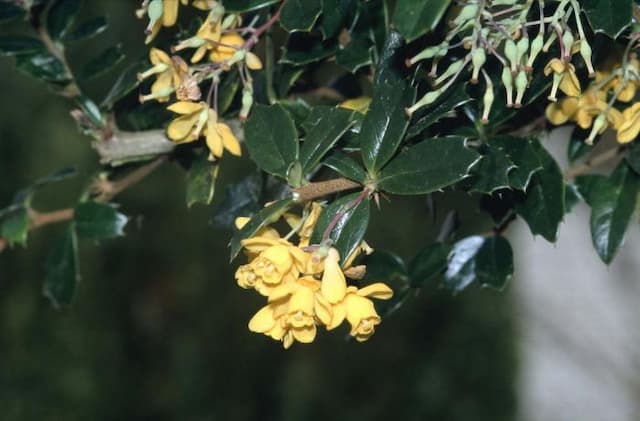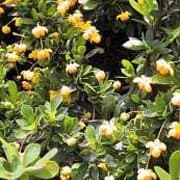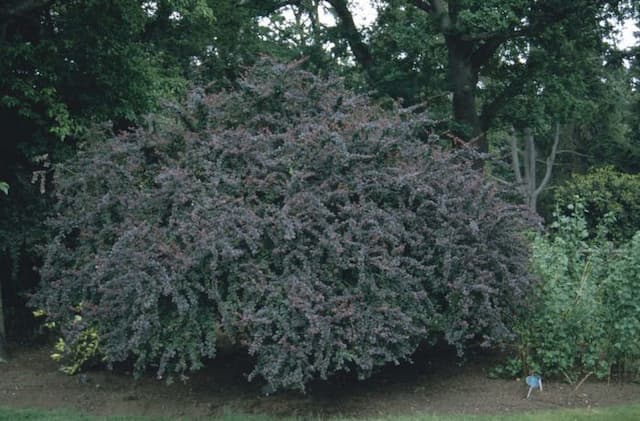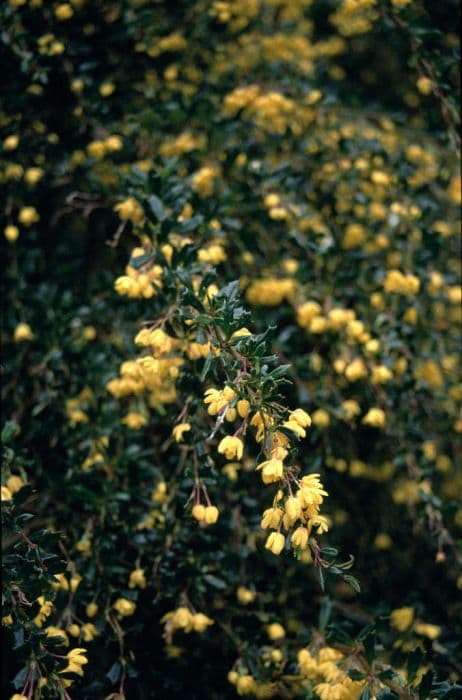Oregon Grape Mahonia nitens 'Cabaret' (PBR)

ABOUT
The Mahonia nitens 'Cabaret' is a visually striking plant, distinguished by its vibrant appearance and architectural foliage. It boasts a striking array of holly-like leaves which are pinnate, with several leaflets set along each side of a central stem. These leaflets have a glossy texture accompanied by a vivid, deep green color that serves as an elegant backdrop to the plant's seasonal features. As seasons shift, this Mahonia becomes a beacon of color. One of the most eye-catching characteristics of this plant are its flowers. Erect spikes adorned with tiny, bright yellow flowers emerge, infusing the plant with a splash of brightness that contrasts splendidly against the dark foliage. These flowers are not only appealing for their color but also possess a subtle, alluring fragrance that adds an extra layer of sensory delight. Following the flowering phase, the plant transitions to bear fruit. The fruits exhibit a blue-black hue when ripe and are held in small clusters, providing yet another shift in visual interest as the growing season progresses. These berries are often appreciated by local birds, which find them to be a tasty treat. Moreover, the leaves of the Mahonia nitens 'Cabaret' sometimes take on warm reddish tones, particularly as the cooler weather sets in, offering a seasonal change in its leaf coloration. This amalgamation of color transformation across its leaves, bright yellow flowers, and attractive berries makes the Mahonia nitens 'Cabaret' a sought-after plant for gardeners who aim to create a year-round spectacle of color in their outdoor spaces. Overall, the Mahonia nitens 'Cabaret' is admired for its layered visual composition, making it a popular choice for adding structure, color, and texture to gardens. Its ability to offer changing scenes throughout the year ensures it remains a central feature in any space it inhabits, regardless of the season.
About this plant
 Names
NamesFamily
Berberidaceae
Synonyms
Oregon Grape, Grape Holly
Common names
Mahonia nitens 'Cabaret' (PBR).
 Toxicity
ToxicityTo humans
The Mahonia nitens 'Cabaret', commonly known as Oregon grape, is not generally considered highly toxic to humans. However, it contains alkaloids such as berberine, which can cause mild stomach upset if ingested in significant quantities. Symptoms of poisoning may include nausea, vomiting, diarrhea, and lethargy. While not severely toxic, it is advisable to avoid consuming parts of this plant, especially the berries and roots, which contain higher concentrations of these compounds.
To pets
The Oregon grape is potentially toxic to pets, including dogs and cats. If pets ingest parts of the plant, especially in large amounts, they can experience symptoms similar to humans, such as vomiting, diarrhea, weakness, and possible confusion due to the alkaloids present in the plant, like berberine. It is recommended to keep pets away from this plant to prevent the risk of poisoning.
 Characteristics
CharacteristicsLife cycle
Perennials
Foliage type
Evergreen
Color of leaves
Green
Flower color
Yellow
Height
4 feet (1.22 meters)
Spread
4 feet (1.22 meters)
Plant type
Shrub
Hardiness zones
7
Native area
Asia
Benefits
 General Benefits
General Benefits- Attractive Foliage: Provides year-round interest with its glossy, deep green leaves that turn into a variety of colors in autumn.
- Easy to Grow: Tolerant of a range of soil types and conditions once established; requires minimal care.
- Drought Resistant: Once established, it can tolerate periods of dry weather, reducing the need for watering.
- Compact Size: Ideal for small gardens or spaces due to its relatively small size and slow growth habit.
- Wildlife Friendly: Produces flowers that are attractive to pollinators such as bees and berries that are a food source for birds in the winter.
- Low Maintenance: Requires little pruning or other care once established, making it a good choice for low-maintenance landscaping.
- Year-Round Interest: Offers visual interest throughout all seasons with its evergreen foliage, flowers in the summer, and berries in the winter.
- Architectural Shape: Its upright and structured form can serve as an eye-catching element in garden design or landscaping.
- Privacy Screen: Can be used as a hedge or screen to provide privacy due to its dense growth.
- Shade Tolerant: Capable of thriving in partially shaded areas where other plants may not perform as well.
- Ornamental Berries: Produces vibrant blue-black berries that add color and visual interest in the autumn and winter months.
 Medical Properties
Medical Properties- This plant is not used for medical purposes.
 Air-purifying Qualities
Air-purifying QualitiesThis plant is not specifically known for air purifying qualities.
 Other Uses
Other Uses- Photography subject: The striking foliage and vibrant color of the Oregon Grape make it an excellent choice for photographers, especially those specializing in botanical or nature photography.
- Barriers: Due to its spiny leaves, Oregon Grape can be planted as a barrier to deter animals and trespassers from entering certain areas of a garden.
- Foliage for arrangements: The leaves of the Oregon Grape can be used in floral arrangements to provide a contrasting texture and long-lasting greenery.
- Insect habitat: Providing a home for beneficial insects, the dense foliage can offer shelter and breeding grounds for these insects which can help in pest control.
- Bee garden addition: As the Oregon Grape produces flowers, it can be used to attract bees and other pollinators, enhancing the health of the entire garden ecosystem.
- Erosion control: Its hardy nature and ability to grow in tough soil conditions make Oregon Grape an excellent choice for stabilizing soil on slopes and preventing erosion.
- Winter garden interest: The persistent fruits and evergreen leaves provide color and texture to gardens even in the winter months when other plants have died back.
- Privacy screening: When planted in a row, Oregon Grape can serve as a living privacy screen, shielding areas from view and helping to reduce noise pollution.
- Educational tool: It can be used in educational settings, such as schools or botanical gardens, to teach about native plant species and their role in local ecosystems.
- Film and theatre set design: Oregon Grape's distinctive appearance can be used by set designers to create natural-looking settings or to evoke certain moods in film and theatre productions.
Interesting Facts
 Feng Shui
Feng ShuiThe Oregon grape is not used in Feng Shui practice.
 Zodiac Sign Compitability
Zodiac Sign CompitabilityThe Oregon grape is not used in astrology practice.
 Plant Symbolism
Plant Symbolism- Protection: Mahonia plants are often associated with protection due to their spiny leaves, which can serve as a barrier against unwanted animals and energies.
- Healing: Some species of Mahonia are used in traditional medicine, symbolizing healing and the restoration of health.
- Endurance: As an evergreen, Mahonia represents durability and the ability to endure challenging conditions.
- Vitality: With its vibrant color and berries, Mahonia often symbolizes vitality and the life force.
 Water
WaterOregon grape 'Cabaret' prefers evenly moist soil, but it is also drought-tolerant once established. Water the plant deeply once a week during dry periods, ensuring you're adding about 1 to 1.5 gallons of water for each watering session, depending on the size and maturity of the plant and the weather conditions. During the growing season in spring and summer, you may need to water more frequently, especially if the week is particularly hot and dry. In the winter, reduce the watering to every two weeks or less, as the plant's water requirements decrease. Always check the soil moisture level before watering; if the top couple of inches of soil are dry, it's time to water.
 Light
LightOregon grape 'Cabaret' thrives best in partial shade to full sun. It is most successful when placed in a location where it can receive morning sunlight and afternoon shade, especially in hotter climates. However, the plant is quite adaptable and can also handle full sun in cooler regions, but too much harsh sunlight may scorch the leaves.
 Temperature
TemperatureOregon grape 'Cabaret' is hardy and can withstand a range of temperatures, but it thrives in temperatures between 50°F and 80°F. The plant can survive minimum temperatures down to around 0°F, but it should be protected from extreme cold. It can also tolerate up to about 95°F, though prolonged exposure to heat above this can stress the plant.
 Pruning
PruningPruning Oregon grape 'Cabaret' is essential to maintain its shape and to encourage new growth. Prune in late winter or early spring, just before new growth starts, by removing dead or damaged branches and shaping the plant as desired. This species doesn't require frequent pruning; performing this task every other year is generally sufficient unless there is visible damage or disease that necessitates more regular maintenance.
 Cleaning
CleaningAs needed
 Soil
SoilOregon grape 'Cabaret' thrives in well-draining soil with a slightly acidic to neutral pH between 5.5 and 7.2. A soil mix of loam, peat or compost, and sand or perlite is ideal for ensuring proper drainage while retaining adequate moisture.
 Repotting
RepottingOregon grape 'Cabaret' should be repotted every 2 to 3 years to refresh the soil and accommodate root growth. Look for signs such as roots growing through the drainage holes as indicators for when repotting is necessary.
 Humidity & Misting
Humidity & MistingOregon grape 'Cabaret' prefers moderate humidity levels but is quite adaptable and can tolerate the lower humidity typically found in home environments. There's no need for adjustments unless air is particularly dry.
 Suitable locations
Suitable locationsIndoor
Give bright, indirect light; water when topsoil is dry.
Outdoor
Plant in partial shade; shield from harsh sun.
Hardiness zone
5-9 USDA
 Life cycle
Life cycleMahonia nitens 'Cabaret' (often known as Oregon grape) begins its life cycle when the seeds germinate, usually requiring a period of cold stratification to break dormancy. The seedlings then develop into juvenile plants with compound leaves that grow in whorls along the stems. As the plant matures, it forms an evergreen shrub with pinnate leaves that have spiny-toothed leaflets, and in summer to early autumn, it produces upright racemes of bright yellow flowers. Post pollination, these flowers develop into blue-black berries that can serve as a food source for birds and wildlife, which also aids in seed dispersal. Over time, the shrub can form clumps through basal shoots, becoming denser and potentially producing new flowering stems. Mahonia nitens 'Cabaret' has a perennial life cycle and can live for many years, going through repeated seasons of flowering and fruiting.
 Propogation
PropogationPropogation time
Late summer
The most popular method of propagating Mahonia nitens 'Cabaret', commonly known as the Oregon grape, is through semi-hardwood cuttings. This process typically takes place during the late summer, when the growth from that season begins to harden. To undertake this form of propagation, gardeners cut a piece of the semi-hardwood stem about four to six inches in length (10 to 15 centimeters), ensuring that there are several leaf nodes present. The lower leaves are removed, and the cut end is often dipped in rooting hormone to encourage root development. The prepared cutting is then placed in a well-draining potting mix, kept consistently moist, and covered with a plastic bag or placed in a propagator to maintain high humidity around the cutting. Roots generally develop within a few weeks to a few months, after which the new Oregon grape plant can be transplanted to a larger pot or into the garden.









